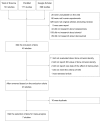The therapeutic efficacy of denosumab for the loss of bone mineral density in glucocorticoid-induced osteoporosis: a meta-analysis
- PMID: 32373775
- PMCID: PMC7197806
- DOI: 10.1093/rap/rkaa008
The therapeutic efficacy of denosumab for the loss of bone mineral density in glucocorticoid-induced osteoporosis: a meta-analysis
Abstract
Objective: Prevention of steroidal osteoporosis is an important issue. There is no clear consensus on the impact of anti-RANKL antibody (denosumab) on BMD in patients with glucocorticoid-induced osteoporosis (GIO). In this study, we aimed to evaluate the impact of denosumab on BMD loss in patients with GIO.
Methods: A comprehensive systematic review and meta-analysis was conducted in accordance with the Preferred Reporting Items for Systematic Reviews and Meta-analyses (PRISMA) guidelines. PubMed, Web of Science and Google Scholar were used to search for original studies reported about BMD in patients with GIO treated with denosumab. In meta-analysis of BMD, the mean difference in the rate of change from baseline and the 95% CI were calculated using the random effects model. The mean differences in patients treated with denosumab were compared with those in patients treated with bisphosphonates.
Results: Out of 713 studies identified, seven studies met the selection criteria for the meta-analysis. At 6 and 12 months of denosumab therapy, increases in BMD were observed in the lumbar spine (2.99% [95% CI 2.71, 3.28] and 4.59% [95% CI 4.17, 5.01]), total hip (1.34% [95% CI 0.64, 2.04] and 2.16% [95% CI 2.05, 2.27]) and femoral neck (0.12% [95% CI -0.38, 0.62] and 1.55% [95% CI 0.45, 2.65]). Additionally, denosumab resulted in significant increases in BMD in the lumbar spine and femoral neck at 12 months compared with bisphosphonate therapy.
Conclusion: Patients with GIO experienced significant increases in BMD in response to treatment with denosumab that were detected in the lumbar spine, total hip and femoral neck at 12 months.
Keywords: anti-RANKL antibody; bone mineral density; denosumab; glucocorticoid-induced osteoporosis; meta-analysis.
© The Author(s) 2020. Published by Oxford University Press on behalf of the British Society for Rheumatology.
Figures





Similar articles
-
Denosumab, teriparatide and bisphosphonates for glucocorticoid-induced osteoporosis: a Bayesian network meta-analysis.Front Pharmacol. 2024 Jan 19;15:1336075. doi: 10.3389/fphar.2024.1336075. eCollection 2024. Front Pharmacol. 2024. PMID: 38313307 Free PMC article.
-
Therapeutic efficacy of denosumab for rheumatoid arthritis: a systematic review and meta-analysis.Rheumatol Adv Pract. 2021 Dec 17;5(3):rkab099. doi: 10.1093/rap/rkab099. eCollection 2021. Rheumatol Adv Pract. 2021. PMID: 34988358 Free PMC article.
-
Effects of denosumab versus teriparatide in glucocorticoid-induced osteoporosis patients with prior bisphosphonate treatment.Bone Rep. 2020 Jul 4;13:100293. doi: 10.1016/j.bonr.2020.100293. eCollection 2020 Dec. Bone Rep. 2020. PMID: 32676524 Free PMC article.
-
The clinical benefits of denosumab for prophylaxis of steroid-induced osteoporosis in patients with pulmonary disease.Arch Osteoporos. 2017 Dec;12(1):44. doi: 10.1007/s11657-017-0336-1. Epub 2017 Apr 19. Arch Osteoporos. 2017. PMID: 28425086
-
Comparison of denosumab and oral bisphosphonates for the treatment of glucocorticoid-induced osteoporosis: a systematic review and meta-analysis.BMC Musculoskelet Disord. 2022 Nov 29;23(1):1027. doi: 10.1186/s12891-022-05997-0. BMC Musculoskelet Disord. 2022. PMID: 36447169 Free PMC article.
Cited by
-
Denosumab, teriparatide and bisphosphonates for glucocorticoid-induced osteoporosis: a Bayesian network meta-analysis.Front Pharmacol. 2024 Jan 19;15:1336075. doi: 10.3389/fphar.2024.1336075. eCollection 2024. Front Pharmacol. 2024. PMID: 38313307 Free PMC article.
-
Therapeutic efficacy of denosumab for rheumatoid arthritis: a systematic review and meta-analysis.Rheumatol Adv Pract. 2021 Dec 17;5(3):rkab099. doi: 10.1093/rap/rkab099. eCollection 2021. Rheumatol Adv Pract. 2021. PMID: 34988358 Free PMC article.
-
Loss of lower extremity bone mineral density 1 year after denosumab is discontinued in persons with subacute spinal cord injury.Osteoporos Int. 2023 Apr;34(4):741-748. doi: 10.1007/s00198-023-06679-w. Epub 2023 Feb 3. Osteoporos Int. 2023. PMID: 36735054 Clinical Trial.
-
Efficacy and safety of 18 anti-osteoporotic drugs in the treatment of patients with osteoporosis caused by glucocorticoid: A network meta-analysis of randomized controlled trials.PLoS One. 2020 Dec 16;15(12):e0243851. doi: 10.1371/journal.pone.0243851. eCollection 2020. PLoS One. 2020. PMID: 33326444 Free PMC article.
-
Prevention and Treatment of Glucocorticoid-Induced Osteoporosis in Adults: Consensus Recommendations From the Belgian Bone Club.Front Endocrinol (Lausanne). 2022 Jun 9;13:908727. doi: 10.3389/fendo.2022.908727. eCollection 2022. Front Endocrinol (Lausanne). 2022. PMID: 35757436 Free PMC article. Review.
References
-
- Buckley L, Humphery MB.. Glucocorticoid-induced osteoporosis. N Eng J Med 2018;379:3547–56. - PubMed
-
- Liu X, Lei W, Wu A. et al. Effects of glucocorticoid on BMD, micro-architecture and biomechanics of cancellous and cortical bone mass in OVX rabbits. Med Eng Phys 2012;34:2–8. - PubMed
-
- van Staa T. P, Leufkens HGM, Cooper C.. The epidemiology of corticosteroid-induced osteoporosis: a meta-analysis. Osteoporos Int 2002;13:777–87. - PubMed
-
- Buckley L, Guyatt G, Fink HA.. 2017 American College of Rheumatology guideline for the prevention and treatment of glucocorticoid-induced osteoporosis. Arthritis Care Res 2018;70:949–50. - PubMed
-
- Graham G, Russell G.. Bisphosphonates: the first 40 years. Bone 2011;49:2–19. - PubMed
Publication types
LinkOut - more resources
Full Text Sources
Miscellaneous
